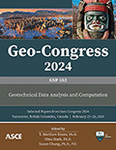Stability Prediction of Highway Slope on Highly Plastic Clay Using Particle Swarm Optimization (PSO)-Based Neural Network
Publication: Geo-Congress 2024
ABSTRACT
It’s a critical task to ensure the safety of highway slopes constructed on highly plastic clay, given their significant economic, social, and safety impacts and the unique geotechnical challenges that they pose. The factor of safety (FS) for a slope is not constant, and it continues to evolve as a function of the weather condition, soil moisture content, and matric suction. Increasing heavy rainfall driven by climate change puts existing slopes at greater risk of failure. In this research, our goal is to create a particle swarm optimization (PSO)-based neural network (NN) (hybrid) model for predicting the long-term FS of highway slopes constructed on highly plastic clay considering the aforementioned factors. In order to obtain the necessary data for training the model, a series of 2D and 3D finite element analyses were performed, which were validated using a slope monitoring case study. In addition, sensitivity analyses were carried out to examine and assess the key factors that influence the FS of highway slopes. The developed PSO-based NN model can provide accurate FS predictions with a very low value of root mean square error.
Get full access to this article
View all available purchase options and get full access to this chapter.
REFERENCES
Adhikari, R., and Agrawal, R. (2011). “Effectiveness of PSO Based Neural Network for Seasonal Time Series Forecasting.” IICAI, 3:231–44.
Akbarimehr, D., Eslami, A., Aflaki, E., and Imam, R. (2020). “Using empirical correlations and artificial neural network to estimate compressibility of low plasticity clays.” Arabian Journal of Geosciences, 13, 1–11.
Cai, J.-S., Yeh, T.-C. J., Yan, E.-C., Tang, R.-X., Hao, Y.-H., Huang, S.-Y., and Wen, J.-C. (2019). “Importance of variability in initial soil moisture and rainfalls on slope stability.” Journal of Hydrology, Elsevier, 571, 265–278.
Cheng, Y. M., Li, L., Chi, S. C., and Wei, W. B. (2007). “Particle swarm optimization algorithm for the location of the critical non-circular failure surface in two-dimensional slope stability analysis.” Computers and Geotechnics, 34(2), 92–103.
Davar, S., Nobahar, M., Khan, M. S., and Amini, F. (2022). “The development of PSO-ANN and BOA-ANN models for predicting matric suction in expansive clay soil.” Mathematics, 10(16), 2825.
Eslami, A., Nabizadeh, S. F., and Talebi, H. R. (2009). “Using CPT and CPTu Results for Determination of Soil Shear Strength Parameters Consideration with 16 Practical Cases.” Journal Of Civil Engineering (Journal Of School Of Engineering), 21(1), 91–109.
Gao, S., Zhou, M., Wang, Y., Cheng, J., Yachi, H., and Wang, J. (2018). “Dendritic neuron model with effective learning algorithms for classification, approximation, and prediction.” IEEE Trans Neural Networks Learn Syst, 30:601–14.
Goodfellow, I., Bengio, Y., and Courville, A. (2016). Deep learning. MIT press.
Gordan, B., Jahed Armaghani, D., Hajihassani, M., and Monjezi, M. (2016). “Prediction of seismic slope stability through combination of particle swarm optimization and neural network.” Eng Comput.
Kennedy, J., and Eberhart, R. C. (1995). “A discrete binary version of the particle swarm algorithm.” Syst. Man, Cybern. 1997. Comput. Cybern. Simulation., 1997 IEEE Int. Conf., vol. 5, IEEE, p. 4104–8.
Khan, M. S., Amini, F., and Nobahar, M. (2020). Performance Evaluation of Highway Slopes on Yazoo Clay. Mississippi. Dept. of Transportation.
Khan, M. S., Ivoke, J., Nobahar, M., and Amini, F. (2021). “Artificial Neural Network (ANN) Based Soil Temperature Model of Highly Plastic Clay.” Geomechanics and Geoengineering, Taylor & Francis, 1–17.
Khari, M., Armaghani, D. J., and Dehghanbanadaki, A. (2019). “Prediction of Lateral Deflection of Small-Scale Piles Using Hybrid PSO–ANN Model.” Arab J Sci Eng.
National Oceanic and Atmospheric Administration, National Climate Report. (2023). <https://www.ncei.noaa.gov/access/billions/>, Accessed 01 May 2023.
Nobahar, M., and Khan, M. S. (2021). “Prediction of Matric Suction of Highway Slopes Using Autoregression Artificial Neural Network (ANN) Model.” In Geo-Extreme 2021 (pp. 40–50).
Nobahar, M., Khan, M. S., Stroud, M., Amini, F., and Ivoke, J. (2021). “Progressive Development of the Perched Water Zone in Highway Slopes Made of Highly Plastic Clay.” Transportation Research Record, 2675(9), 715–728.
Ozturk, T. E. (2014). “Artificial neural networks approach for earthquake deformation determination of geosynthetic reinforced retaining walls.” Int J Intell Syst Appl Eng, 2:1–9.
Xue, X. (2017). “Prediction of slope stability based on hybrid PSO and LSSVM.” Journal of Computing in Civil Engineering, 31(1), 04016041.
Zhou, J., Li, E., Yang, S., Wang, M., Shi, X., and Yao, S. (2019). “Slope stability prediction for circular mode failure using gradient boosting machine approach based on an updated database of case histories.” Saf Sci, 118:505–18.
Information & Authors
Information
Published In
History
Published online: Feb 22, 2024
ASCE Technical Topics:
- Analysis (by type)
- Business management
- Clays
- Engineering fundamentals
- Engineering materials (by type)
- Geomechanics
- Geotechnical engineering
- Infrastructure
- Materials engineering
- Plastics
- Practice and Profession
- Public administration
- Public health and safety
- Safety
- Sensitivity analysis
- Slopes
- Soil mechanics
- Soils (by type)
- Synthetic materials
- Traffic engineering
- Traffic management
- Traffic signs
- Transportation engineering
- Transportation management
- Transportation networks
Authors
Metrics & Citations
Metrics
Citations
Download citation
If you have the appropriate software installed, you can download article citation data to the citation manager of your choice. Simply select your manager software from the list below and click Download.
